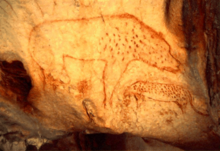洞鬣狗
| 洞鬣狗 化石时期:中至晚更新世
| |
|---|---|

| |
史前
| |
| 科学分类 | |
| 界: | 动物界 Animalia |
| 门: | 脊索动物门 Chordata |
| 纲: | 哺乳纲 Mammalia |
| 目: | 食肉目 Carnivora |
| 科: | 鬣狗科 Hyaenidae |
| 属: | 斑鬣狗属 Crocuta |
| 种: | 斑鬣狗 C. crocuta
|
| 亚种: | 洞鬣狗 C. c. spelaea
|
| 三名法 | |
| Crocuta crocuta spelaea | |
洞鬣狗(学名:Crocuta crocuta spelaea)是斑鬣狗已灭绝的一个亚种[1],分布于伊比利半岛至西伯利亚东部[2]。虽然洞鬣狗最初因前后肢的不同而被描述成独立的物种,但基因分析显示洞鬣狗与斑鬣狗并没有DNA的明显分别。[3]除了洞鬣狗的化石外,一些石洞壁画亦有发现洞鬣狗。洞鬣狗于约2万至1万年前的冰河时期末灭绝,原因仍然未知,但多半认为是气候变迁以及与其他掠食者竞争造成[4][5]。
描述
[编辑]洞鬣狗的体型远大于现存于非洲的斑鬣狗,体重可达 102千克(225磅)[6],掌骨与跖骨也较短而粗壮,肱骨与股骨则较长[7],这是为了生活于和斑鬣狗不同的环境所做出的适应[8]。与斑鬣狗同样为两性异形,雌性鬣狗体型大于雄性[9]。由一些石洞壁画可知,洞鬣狗和斑鬣狗一样具有斑点[10]。
对于洞鬣狗的社交习性只知很少。一般接受牠们都是生活在洞穴中。现时未有显示牠们是成群生活或是独自生活的,但更新世环境似乎不可能有成群生活的动物。[3]
食性
[编辑]洞鬣狗像现今的鬣狗般会在巢穴积存猎物的骨头及角,供日后食用或玩耍,但这些骨头并不清楚是属于腐尸的或是被猎杀的动物。就波西米亚岩洞内遗骸的研究显示,普氏野马明显是牠们的猎物,约占16-51%。洞鬣狗最大的猎物是披毛犀,在很多洞鬣狗的巢穴中都有发现牠们的骨头及头颅骨。在一些区域,披毛犀占其猎物的25-30%。驯鹿亦是另一个重要的食物来源,约占7-15%。长角野牛及马鹿分别占1-6%及3%,其他的亦包括了爱尔兰麋鹿、臆羚及野山羊则只有少于3%。[11]
一般相信洞鬣狗是将洞熊骨骼拆解及破坏的元凶。这么大型的腐肉是洞鬣狗的重要食物,尤其是在冬季当食物短缺时。穴狮、狼及貂熊的遗骸亦于洞鬣狗的巢穴发现。另外有证据显示洞鬣狗有时会同类相食的。[11]
与人科的关系
[编辑]
有证据指洞鬣狗会偷取尼安德特人的猎物,而牠们亦会为洞穴而竞争,并会取代对方拥有该洞穴。在洞鬣狗的骨头积存中亦发现有大量的人科骨头,包括尼安德特人的。现今人类亦会与洞鬣狗并存,估计他们之间亦有相似的关系。
参考文献
[编辑]- ^ Rohland, N, Pollack, JL, Nagel, D, Beauval, C, Airvaux J, Paabo, S & Hofreiter, M, 2005. The population history of extant and extinct hyenas. Molecular Biology and Evolution,. 22: 2435-2443.
- ^ Summerill, Lynette; Gnawed Bones tell Tales (页面存档备份,存于互联网档案馆), Summer 2003, ASU Research
- ^ 3.0 3.1 Comparison of Crocuta crocutacrocuta and Crocuta crocutaspelaea through computertomography (PDF). Dockner, Martin. Department of Paleontology, University of Vienna. [2008-01-20]. (原始内容 (PDF)存档于2011-05-22).
- ^ C. Stiner, Mary (2004) Comparative ecology and taphonomy of spotted hyenas, humans, and wolves in Pleistocene Italy (页面存档备份,存于互联网档案馆), Revue de Paléobiologie, Genève. (December 2004) 23 (2) : 771-785. ISSN 0253-6730
- ^ Varela, S., Lobo, J. M., Rodríguez, J. and Batra, P. (2010). Were the Late Pleistocene climatic changes responsible for the disappearance of the European spotted hyena populations? 互联网档案馆的存档,存档日期2012-04-26. Quaternary Science Reviews, 29: 2027-2035.
- ^ Meloro, C., 2007. Plio-Pleistocene large carnivores from the Italian peninsula: functional morphology and macroecology (页面存档备份,存于互联网档案馆). Ph.D. Thesis, Univ. Naples Federico II.
- ^ Kurtén, Björn (1968). Pleistocene mammals of Europe. Weidenfeld and Nicolson. pp. 69-72.
- ^ Dockner, M., 2006. Comparison of Crocuta crocuta crocuta and Crocuta crocuta spelaea through computer tomography. Ph.D. Thesis, Univ. Vienna, Austria.
- ^ DIEDRICH, C.G. & ŽÁK, K. 2006. Prey deposits and den sites of the Upper Pleistocene hyena Crocuta crocuta spelaea (Goldfuss, 1823) in horizontal and vertical caves of the Bohemian Karst (Czech Republic) (页面存档备份,存于互联网档案馆). Bulletin of Geosciences 81(4), 237–276 (25 figures). Czech Geological Survey, Prague. ISSN 1214-1119.
- ^ Spassov N.; Stoytchev T. 2004. The presence of cave hyaena (Crocuta crocuta spelaea) in the Upper Palaeolithic rock art of Europe (页面存档备份,存于互联网档案馆). Historia naturalis bulgarica, 16: 159-166.
- ^ 11.0 11.1 Prey deposits and den sites of the Upper Pleistocene hyena Crocuta crocuta spelaea (Goldfuss, 1823)in horizontal and vertical caves of the Bohemian Karst (PDF). Cajusg. Diedrich & Karelzák. [2008-01-20].[永久失效链接]
